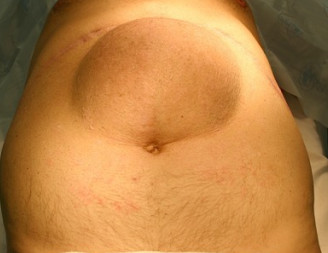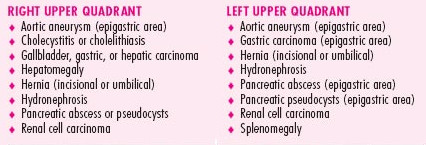Article Contents ::
Abdominal Mass Signs and Symptoms
- Typically, this sign develops insidiously and may represent an enlarged organ, a neoplasm, an abscess, a vascular defect, or a fecal mass.
- Commonly detected on routine physical examination, an abdominal mass is a localized swelling in one abdominal quadrant.
- Distinguishing an abdominal mass from a normal structure requires skillful palpation.
- A palpable abdominal mass is an important clinical sign and usually represents a serious and perhaps life-threatening disorder.
- At times, palpation must be repeated with the patient in a different position or performed by a second examiner to verify initial findings.

History and Physical Examination Abdominal Mass
- patient’s abdominal mass doesn’t suggest an aortic aneurysm, continue with a detailed history.
- Ask the patient if the mass is painful. If so, ask if the pain is constant or if it occurs only on palpation.
- noticed any change in the size or location of the mass.
- Determine if the patient was already aware of the mass.
- Is it localized or generalized?
- Determine the consistency of the mass. Is it doughy, soft, solid, or hard
- mass moves with your hand or in response to respiration


Abdominal Mass Medical Cause(s)
- Cholecystitis. Deep palpation below the liver border may reveal a smooth, firm, sausage-shaped mass
- Abdominal aortic aneurysm. Abdominal aortic aneurysm may persist for years, producing only a pulsating periumbilical mass with a systolic bruit over the aorta, After rupture, the aneurysm no longer pulsates
- Colon cancer. A right lower quadrant mass may occur with cancer of the right colon, which may also cause occult bleeding with anemia and abdominal aching, pressure, or dull cramps
- Gastric cancer. Advanced gastric cancer may produce an epigastric mass
- Diverticulitis. Most common in the sigmoid colon, diverticulitis may produce a left lower quadrant mass that’s usually tender, firm, and fixed.
- Hydronephrosis. Enlarging one or both kidneys, hydronephrosis produces a smooth, boggy mass in one or both flanks
- Hernia. The soft and typically tender bulge is usually an effect of prolonged
- Hepatomegaly produces a firm, blunt, irregular mass in the epigastric region or below the right costal margin
- Ovarian cyst. A large ovarian cyst may produce a smooth, rounded, fluctuant mass, resembling a distended bladder, in the suprapubic region.
- Splenomegaly. The lymphomas, leukemias, hemolytic anemias, and inflammatory diseases
- Uterine leiomyomas (fibroids). If large enough, these common
EMERGENCY INTERVENTIONS
- If the patient has a pulsating midabdominal mass and severe abdominal or back pain, suspect an aortic aneurysm.

